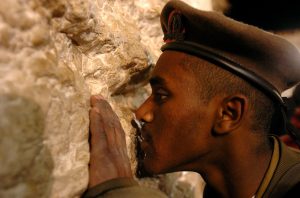 Another new meeting this year was with Oshra Friedman of Tebeka legal services, an organization that provides specialized legal services for the Ethiopian immigrants to Israel. As we learned on our last trip, Israel has welcomed thousands of immigrants from Ethiopia of Jewish heritage and assimilation into the modern society of Israel can be very challenging. As we also saw last time, these challenges can remind us and cause us to reflect on the challenges of race here in Milwaukee. From Student Sheila Thobani:
Another new meeting this year was with Oshra Friedman of Tebeka legal services, an organization that provides specialized legal services for the Ethiopian immigrants to Israel. As we learned on our last trip, Israel has welcomed thousands of immigrants from Ethiopia of Jewish heritage and assimilation into the modern society of Israel can be very challenging. As we also saw last time, these challenges can remind us and cause us to reflect on the challenges of race here in Milwaukee. From Student Sheila Thobani:
Before we even discussed paper topics prior to departing for Israel, thoughts about the conflict were already flooding my mind. Not the cliché thoughts of the obvious conflict, the talked about every day in the media conflict, but one that I had a more personal association with: identity. I believe that is why Oshra Friedman’s narrative engaged my curiosity.
With the constant comments in public about my physical characteristics, one-second longer than comfortable gazes, and second-guess pseudo interrogations by people of authority—I was waiting at the edge of my chair to see how someone who looked different than every other person on the streets of Israel dealt with her diversity. An immigrant from Ethiopia, whose parents refused to assimilate, who jumped forward too far because her community was too backwards, who didn’t succumb to gender norms, who married an Ashkenazi Israeli- this was a story I was all too familiar with; a familiarity not by exposure but by experience.
Whereas, over the border and across the sea, America has heard Friedman’s story of diversity for generations, Israel is still becoming familiar with this narrative. By no means do I mean to convey that because in America the story is heard that it is accepted and internalized- I only mean that it is there that there is the exposure and familiarity. As Friedman spoke about her mixed race children handling the innocence of childhood and the ignorance of adults, and agave accounts of situations they faced, I relived my own childhood memories of confusion colored by pride.
I appreciated the faith she had in her children, who were not even young adults yet, on handling their identity against those who may not understand or even accept them. It was refreshing to have a strong diverse woman reassure that it is not sullen silence but a loud and constant stream of emotional and educational discourse that dissolves ignorance.
And from student Megan Harmon:
On our last day of the trip, Oshra Friedman visited our group to talk about her experience as an Ethiopian Jew living in Israel and the experience of so many others. As I suspected, both her and her children had encountered forms of racism and discrimination both implicit and direct. She made it a point to distinguish between ignorance and racism, characterizing the latter as having a component of intentionality and coming from a darker place mostly rooted in hatred. As an African American woman, I could identify and relate to much of Ms. Friedman’s narrative and the uncomfortable feeling of having to justify your belonging. What struck me from the talk Ms. Friedman gave was her response to racism and negativity. She simply stated “they do not know me; I do not take it personal because they do not know me.” She made this statement as to say had the person who acted toward her in racism known her as a person and not who they perceived her to be based on stereotypes, their actions or response would have most likely have been something different. She went on to speak about the importance of teaching culture to others and teaching them how to think in order to begin breaking down those metaphorical walls of division that perpetuate stereotypes and lead to the creation of the ‘other.’
I posed the question to Ms. Friedman on how do we go about teaching culture and teaching others how to rethink about people who may have different features, backgrounds and histories than their own. Doesn’t that require a willingness on the part of the participant to first recognize that there is something to be discussed and second a willingness to actively engage in purposeful dialogue, a willingness to learn? Her response was that you teach at every moment there is an opportunity. Each moment you are confronted with discrimination or racism take the time to correct the misguided individual spewing ignorance or hate. At the time I accepted this response, but the more I thought about it, the more unsatisfying the response became for me. It was not that I felt that I had a better response than Ms. Friedman gave because it was something that I had been engrained in me since I was a child. I was taught through experience that because I was black it would somehow become my responsibility to help those who did not understand my blackness overcome stereotypes about my identity by my actions and teaching moments. One of the problems for me was that the response places the bulk of the burden of overcoming ignorance and racism on the recipient of the racism rather than the individual dishing it out. Another problem for me was the fact teaching moments seem to come as a reaction to the discrimination or racism that has already taken place and not enough as a preventative measure. What I mean by this is that teaching moments often happen on a individual level, one-on-one, in a particular moment, addressing a particular instance that may or may not resonate or have any long term implications for the individual that has been “taught.” I was left wondering and still wondering, how do we teach culture before those teaching moment arise to those unwilling to engage?
Cross-posted at Indisputably.org.
